TL;DR
Overwhelmed by golden oak or heavy wood paneling? This guide shows how to break up too much wood without painting: bigger light rugs, layered window treatments, greenery, art, and a cooler color palette. Learn easy DIY home décor projects for small spaces and large rooms alike that keep the wood intact and the vibe refreshed.
Quick read: Light rugs, color-forward textiles, plants, better lighting, and filled bookcases create contrast fast — no wood paint required.
Why wood feels overwhelming — and why it doesn’t have to

Combining varied wood tones with soft textiles and greenery adds texture and contrast without paint.
Wood-rich rooms are back, and for good reason: they’re durable, sustainable, and deeply characterful. But here’s the thing — when floors, beams, built-ins, and furniture all sit in the same cinnamon-to-honey range, even beautiful craftsmanship can blur into one flat field.
Designers often note that it’s not the wood that’s the problem; it’s the lack of counterpoints. Balance comes from contrast, texture, and light. I’ve seen this happen in a day: a homeowner swapped a brown rug for an oatmeal loop, added two leafy plants, and suddenly the fireplace sang.
If painting wood is off the table, good. These 2025 decorating ideas treat wood as the hero while restoring visual rhythm. Let’s add softness, cool tones, and scale — the kind that makes a craftsman living room or paneled den feel intentional again.
A unifying idea for rooms with wood: contrast, softness, scale
DIY home décor, budget decorating ideas, and small-space hacks all hinge on three levers: lighten the ground plane, frame the verticals, and layer color away from the wood. Early wins include a large area rug, window treatments, and art — the trio most experts recommend tackling first.
Think of it as a 60/30/10 approach: 60 percent neutrals that soften wood (creams, oatmeals), 30 percent color that cools it (greens, blues), and 10 percent high-contrast accents (black, deep indigo, aged brass). That ratio works in living rooms, dining nooks, and hallways alike.
Anecdote
In a craftsman bungalow with orange-toned floors and beams, we swapped a camouflaging brown rug for a pale wool, added two linen curtain panels, and tucked a tall ficus near the fireplace. In under two hours, the wood looked special rather than overwhelming — the homeowners couldn’t believe it was the same room.
DIY Hacks & Tricks
01. The Big Light Rug Rule for Wood Floors
For wood-on-wood rooms, a large light rug breaks up floor expanse and instantly cools warm tones. Experts recommend sizing so front legs of all main seating sit on the rug, with 8–12 inches of floor showing around the perimeter.
What it is: A pale, textured rug (oatmeal, cream, heathered taupe) that lifts the room and separates wood furniture from wood floors.
How it works: Light-value textiles counterbalance the visual weight of golden oak and orange wood. A 9×12 under a standard sofa-plus-chairs grouping usually reads balanced; in long rooms, consider a 10×14. Texture matters — flatweave, wool loop, or jute-over-wool adds shadow and interest without more brown. If you love pattern, a faded Persian in blues/greens is a classic foil for wood. Rule of thumb: avoid a rug within one shade of your flooring; aim for at least two steps lighter on a paint strip.
- Measure for scale: seat fronts on rug, at least 24 inches wide under a coffee table.
- Pick cool undertones: oatmeal, greige, or blue-green patterning.
- Layer trick: a budget jute base with a smaller vintage rug on top adds depth.
Caption idea: Large cream wool rug calming oak floors. Alt text idea: Light rug grounding a wood-heavy living room.
02. Window Treatments that Soften Wood
Layered window treatments add vertical softness, absorb sound, and reduce glare on glossy wood. Designers often advise curtain rods 6–10 inches wider than the window and panels that kiss the floor.
What it is: Linen or cotton curtains over tailored shades that introduce movement, color, and texture against rigid wood lines.
How it works: Shades control light; drapery adds volume and color. Choose fabrics with cool or neutral undertones — mineral green, slate blue, oatmeal heather — to counter warm trim. For fullness, use 2–2.5× the window width. If blinds feel too hard, swap for woven wood shades in a lighter, ashy tone to avoid matching the floor. A simple black or antique brass rod creates a crisp edge that frames the woodwork.
- Mount rods high: 4–6 inches above the frame to stretch the wall.
- Choose 3000K or warmer bulbs nearby so fabrics glow, not glare.
- Repeat color from the rug for a calm, cohesive palette.
03. A Cooler Color Palette (Greens + Blues)
Cool colors neutralize orange wood; sages, blue-grays, and inky teals are reliable partners. Experts recommend picking one dominant color and repeating it at least three times in the room.
What it is: A restrained palette that threads through pillows, throws, lamp bases, art, and a patterned rug — not more brown.
How it works: Color temperature is chemistry: green sits opposite red/orange, so it calms golden oak. Aim for mid-tone saturation to avoid chalkiness against rich wood. Try a trio like sage, denim blue, and ivory. Anecdote: in a 1920s bungalow, we introduced a moss velvet pillow pair, a denim throw, and a landscape print — the beams looked intentional overnight. Rule of thumb: apply your accent color at eye level, seat level, and floor level for balance.
- Start with two pillow pairs and a throw.
- Mix textures: velvet, tweed, linen for depth without clutter.
- Ground with one dark note, like an indigo vase or black metal lamp.
04. Fill the Built-ins (and Back Them)
Full bookcases read as color fields that punctuate wood; empty shelves amplify sameness. Designers often target 60 percent books, 30 percent objects, 10 percent negative space.
What it is: Shelves layered with spines, art, and vessels — plus a removable wallpaper or painted back panel in a light neutral or subtle print.
How it works: Books break the monotony with micro-color. A pale backing sets off both the objects and the wood trim. Choose peel-and-stick linen prints or soft stripes if you’re commitment-shy. Photograph frames in black or brass add crisp edges. I’ve watched a client install a parchment-tone backing and style by color blocks; the fireplace wall suddenly felt curated, not heavy.
- Keep shelf heights varied; stack some books horizontally.
- Use picture lights or puck lights (2700–3000K) to wash the display.
- Add a trailing plant to soften right angles.
05. Statement Lighting Instead of a Ceiling Fan
A single strong fixture pulls the eye upward and away from wood density at eye level. Many pros size pendants or chandeliers as diameter = room width + length in feet.
What it is: A chandelier or lantern in aged brass, matte black, or milk glass that introduces contrast and glow.
How it works: Fans can visually chop a ceiling; a diffused fixture unifies it. With beams, choose a linear lantern or tiered chandelier hung so the bottom sits 30–34 inches above a coffee table. Add dimmers to get layered, evening warmth that flatters wood. Pair with two table lamps for a 3-point lighting plan — ceiling, task, ambient — to avoid hot spots.
- Use dimmable 2700–3000K bulbs for flattering warmth.
- Echo metal finishes across hardware for cohesion.
- Center the fixture on the seating layout, not the room’s geometry.
06. Plants as the Natural Antidote
Greenery introduces living contrast; wood and plants are a timeless duo. Aim for at least two plant heights — 24–36 inches and 48 inches+ — to create layered vertical interest.
What it is: Structural plants (ficus, olive, rubber tree) plus trailing types (pothos, philodendron) to soften hard edges.
How it works: Cool green leaves oppose warm wood on the color wheel. Use light, textured planters (ivory terrazzo, charcoal, stone) rather than more wood. Group in odd numbers and tuck one near the fireplace to break the biggest wood block. A client once added a 6-foot ficus and a mantle pothos; that corner went from heavy to lively without moving a single built-in.
- Choose pots 2 inches wider than the nursery pot for healthy growth.
- Place by bright windows; rotate monthly to keep shape even.
- Elevate one plant on a black metal stand for contrast.
07. Mix Materials: Coffee Tables, Metals, and Textiles
Breaking the wood chain with glass, stone, or upholstered pieces adds essential contrast. A single non-wood coffee table can visually reset the entire seating zone.
What it is: Swap a wood coffee table for stone, glass with a dark base, or an upholstered ottoman; add metal accents in black or brass.
How it works: Materials act like color. Stone cools, glass lightens, fabric softens. Choose a table 2/3 the sofa length and 16–18 inches high for comfortable reach. Add a black metal frame to punctuate honey tones, then repeat that black in a lamp or picture frame. A wool throw over the ottoman invites touch and breaks up the plane.
- Use a tray to stabilize styling on soft ottomans.
- Repeat metals at least twice for intentionality.
- Introduce a stripe or check to contrast all the wood grain.
What these ideas have in common
What ties these ideas together isn’t just frugality — it’s intention. Each move introduces a different visual note: pale ground, soft edges, cooler hues, and living texture.
None of them fight the architecture. They simply let the wood be one voice in a richer chorus, where balance comes from repetition, contrast, and warmth.
Visualize before you DIY
Visualize it before you commit
Previewing color and layout choices reduces costly mistakes; testing a rug or curtain color virtually can save a return trip and a repaint.
Before you rearrange or shop, try your ideas in a digital mockup. Upload a photo to ReimagineHome, test a large light rug, simulate new curtains, drop in plants, or swap a ceiling fan for a chandelier in seconds. Toggle sage vs denim accents, back your shelves with a subtle pattern, and compare 2700K to 3000K lighting — all before making a single hole or order. It’s not just inspiration; it’s a confidence tool for anyone working around beautiful wood.
Visualization Scenario
Unsure whether sage or denim will better cool your golden oak? Upload your living room photo to ReimagineHome, drop in both palettes, and preview each with different rug sizes and lighting temperatures. Save the favorite render and shop with clarity.
FAQ
How do I break up too much wood without painting?
Use a large light rug, layered window treatments, plants, and mixed-material furniture to add contrast and softness while keeping wood intact.
What color rug works with golden oak floors?
Oatmeal, cream, and cool-toned patterns in blue or green are best; pick a rug at least two shades lighter than the floor for clear separation.
Should I replace a ceiling fan with a chandelier in a wood-heavy living room?
A statement chandelier draws the eye up and unifies the ceiling; size by adding the room’s dimensions in feet to get the fixture diameter in inches.
What paint color goes with orange wood trim if I won’t paint the wood?
Choose warm off-whites and gentle neutrals (ivory, linen, ecru) or muted greens and blue-grays to reduce harsh contrast with golden wood.
How many plants should I add to a wood-heavy room?
Start with two to three plants at staggered heights (around 24–36 inches and 48 inches+) to create vertical rhythm and natural color contrast.
How do I style built-in bookshelves with lots of wood around them?
Back shelves with a light neutral or subtle pattern, then aim for 60 percent books, 30 percent objects, and 10 percent space for a curated look.
Live with the wood — beautifully
Rooms layered in wood can feel soulful, not heavy, when you balance them with light textiles, cooler color, and mixed materials. Start with the big moves — a properly scaled rug, window treatments, and art — and let the rest cascade. I’ve watched it happen again and again: the moment you give wood a worthy counterpoint, its character shines.
In 2025, design isn’t about erasing what makes a home unique. It’s about presence. Every plant, panel, and pillow can help you live beautifully with the wood you love — not despite it.
.svg)

.svg)


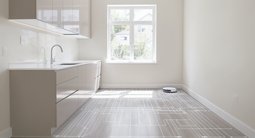
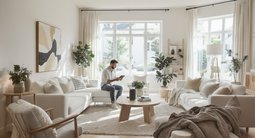
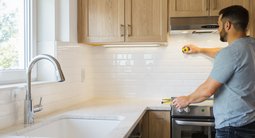

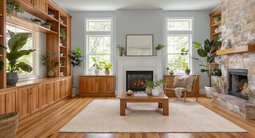
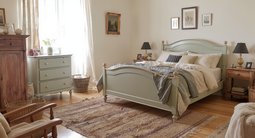






.png)